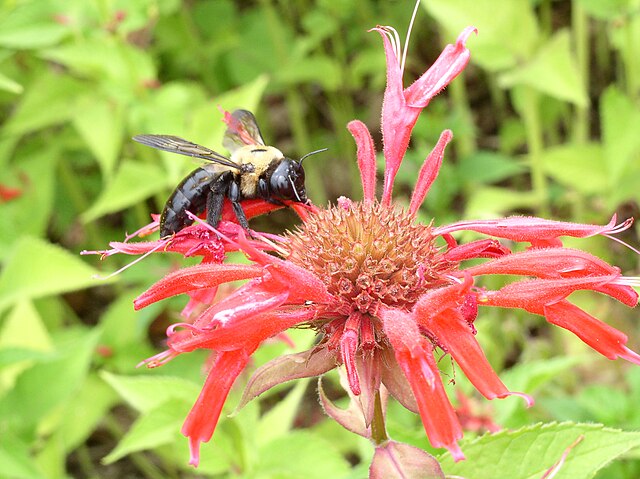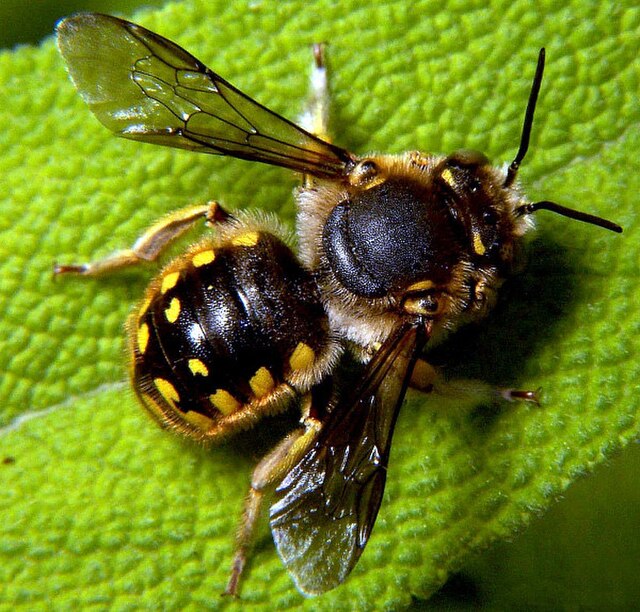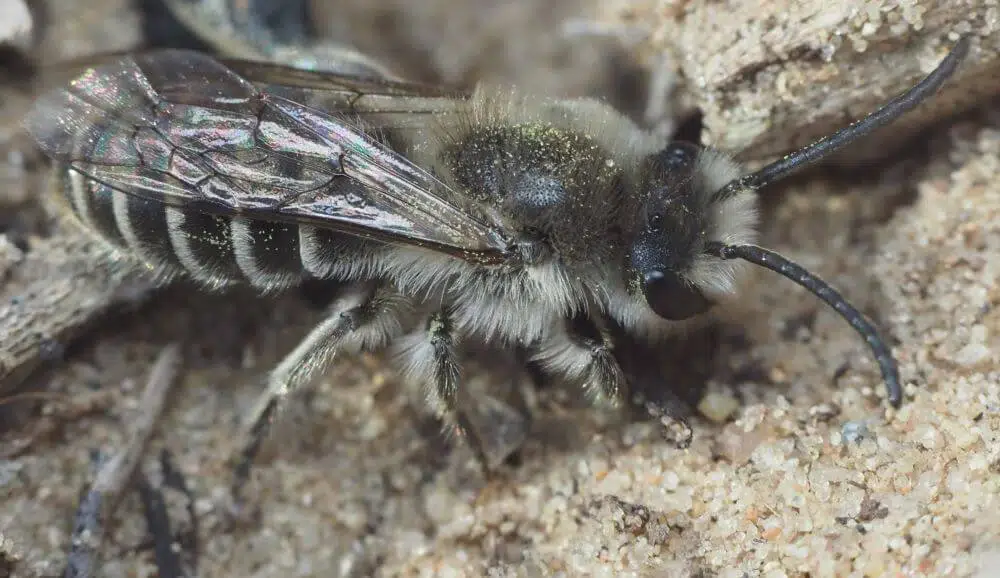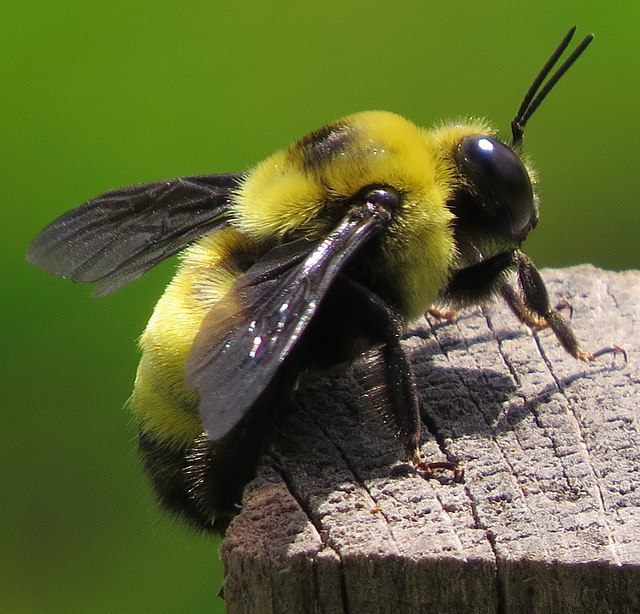There are more than four hundred bee species in Pennsylvania, of which over twenty are not native to North America. Bees are insects, similar to wasps, that are important pollinators, with some making honey.
Continue reading below to find out about the common bees you may encounter in Pennsylvania.
Table of Contents
1. Common Eastern Bumble Bee
The common Eastern bumble bee (Bombus impatiens) is one of the most commonly encountered bumblebees in Pennsylvania. They are very adaptable, living in the country, urban areas, and suburbs. They are an excellent pollinating species.
These bumblebees have short hair with medium-sized heads and long rectangular bodies. The coloring is very similar between the queen and workers. Queens grow to around 23mm in body length, while workers grow to around 16mm and males can grow to 18mm.

Males vary slightly from the queen and workers. The queen and worker bumblebees have black with a yellow thorax, while the male has a yellow head and face.
2. Western Honey Bee

The Western honey bee (Apis mellifera) is a European honey bee. These bees create colonies, which house thousands of bees. It is the primary species for beekeepers for pollination and honey production.
Humans have introduced this bee throughout the world, except in Antarctica. This bee has gone through significant declines throughout Europe and is listed on the IUCN Red List.
These bees are a red/brown color with black banding and orange to yellow rings on the abdomen. Their pollen basket is on their hind legs. Queens grow to 20mm in body length, workers to 15mm, and males to around 17mm.
3. Eastern Carpenter Bee

The Eastern carpenter bee (Xylocopa virginica) can be found throughout the Eastern United States. Their nests can be found in a number of wooded areas, where they feed on nectar and pollen.
These bees are a similar size to bumblebees, but with a mostly black body with a purple tint. Males have a longer body, while females have a wider head. Males also have a white spot on their faces.
4. Brown-belted Bumble Bee

The brown belted bumblebee (Bombus griseocollis) can be found throughout Pennsylvania with queens growing to 23mm in body length with a black face with some yellow hairs. The abdomen is yellow with black banding and their legs are black.
Workers are smaller in size, usually around one centimeter in length with a similar color pattern to the queen, except their banding may be a brown/yellow color. Males grow to around 19mm in body length with large eyes and yellow hairs on their face and thorax. Their abdomens are banded with yellow.
5. Pure Green-Sweat Bee

Pure green sweat bees (Augochlora pura) are solitary bees, known for their bright green coloration. They live in rotting logs, producing up to three generations per year. They are also known for licking the sweat from human skin, hence the name sweat bee.
There is no significant size difference between the males and females, which grow to around 8mm in body length with shiny green bodies.
6. Two-spotted Bumble Bee

Two-spotted bumblebees (Bombus bimaculatus) are social bumblebees with two yellow spots on their abdomens. They are excellent pollinators. There is very little difference between workers and queens, with size being the only distinguishing factor.
Larger workers are often confused as queens. Queens have black faces with a triangular patch of yellow hair. Males have black faces with yellow hairs, though not in a triangular shape.
7. Perplexing Bumble Bee

This bumblebee (Bombus perplexus) is native to North America where the queens grow to around 2.1cm. Queens are mostly black with pale hairs, while worker females grow to 1.4cm. The worker females have more yellow hairs than the females with a black and yellow abdomen.
Males are the same size as the worker females, around 1.4cm in body length. They have white hairs on the legs and head with yellow and white hairs on their thorax.
They are often encountered in wooded areas, urban gardens, and wetland habitats where they feed on a host of plants. They are more common from April to September.
8. Bicolored Striped Sweat Bee

The bicolored striped sweat bees (Agapostemon virescens) are small and they will sting if they are disturbed. They have a metallic green head and thorax, which is bumpy in texture. The abdomen is a common wasp or bee shape with black and yellow banding on the abdomen.
These bees are attracted to human perspiration, it is believed that they are attracted to salt. Their nests are in the ground and they are known to damage lawns. They are beneficial pollinators.
9. Two-spotted Longhorn Bee

The two-spotted longhorn bee (Melissodes bimaculatus) is slightly different from other bees with two pale spots right at the tip of their abdomens. The males have long antennae and they can vary in color. There are two spots at the tip of the abdomen that stand out against their black bodies, helping with identification.
Hind legs have long yellow hairs, which look like a pollen dust. The hairs trap pollen from the flowers that they visit. There is very little size difference between the male and female with males growing to 13mm and females to 15mm.
These bees are more common from May to October, where they can be seen visiting a host of flowers.
10. European Woolcarder Bee

This bee (Anthidium manicatum) belongs to the leafcutter or mason bee and scrapes the hair from leaves. The hair is bundled under their bodies and is used for lining their nests. They do not cut the petals or leaves, which is typical of the family Megachilidae.
Males are territorial and will aggressively chase other males and pollinators from their territory. It was accidentally introduced to North America and has become an invasive pest. These Old World bee females grow to around 13mm and males to 17mm.
These bees have yellow spots on their face and abdomens with a black head and thorax with yellow to brown colored hairs. Their wings are a dusty color and their abdomen with black with gray hairs and a brown band at each segment apex.
Females are smaller than males with a similar color pattern. The spots on the abdomen are smaller with legs being completely black with tiny yellow spots.
11. Golden Northern Bumble Bee

The golden Northern bumblebee or yellow bumblebee (Bombus fervidus) is native to North America. It has a yellow abdomen and thorax and is commonly encountered in farmlands and cities. These bees grow to around 16mm in body length, though there are differences between the queens, workers, and drones.
Queens grow to around 21mm in body length and are black, including the legs. Workers grow to around 10.5mm and are similar to the queen. Drones, grow to 20mm in body length and are also black.
12. Ligated Furrow Bee

The ligated furrow bee (Halictus ligatus) is a sweat bee that mines or burrows to create a nest underground. They are eusocial bees and very aggressive within their colonies. They are mostly black or black/brown with metallic tints and pale fasciae hair bands.
The queens are large-bodied bees, which enables them to overwinter, establish nests and reproduce. Helpers are smaller with undeveloped ovaries.
13. Sculptured Resin Bee

The sculptured resin bee (Megachile sculpturalis), also known as the giant resin bee is a leafcutting bee that belongs to the Megachilidae family. Males can grow to 22mm in body length with females growing to around 25mm in body length.
They have a cylindrical body with large jaws and transparent wings. Their color is brown that darkens at the tips. The head and abdomen are black, hairless, and shiny. The thorax has dense yellow to brown hairs.
These bees are often found around wooden structures, such as porches, decks, and doors.
14. Unequal Cellophane Bee

The unequal cellophane bee (Colletes inaequalis) can grow to 13mm in females and 10mm in males. They can be found throughout Pennsylvania from March to July. These bees visit flowers, where they are important pollinators.
It’s a common plasterer bee from the Colletidae family, which is native to North America. It builds nests underground, lined with a polyester secretion. They pollinate red maple trees, apple trees, and willow trees.
15. Oblong Woolcarder Bee

The oblong woolcarder bee (Anthidium oblongatum) belongs to the Megachilidae family of leafcutters or mason bees. They prefer warm and dry locations and are often seen on grasslands, dry stone walls, hedges, road embankments, flood dams, and in flowering areas, such as gardens.
They create nesting sites close to their pollen source.
16. Horn-faced Mason Bee

The horn-faced mason bee (Osmia cornifrons) is a solitary bee that comes from North Asia and has horn extensions on its lower face. These bees are unlikely to sting if they are aggravated.
They are common in Pennsylvania and used for their effective pollination. A single bee can visit more than two thousand five hundred flowers daily, spending at least four minutes on each flower. They create their nests within close distance of crop fields.
17. Tricolored Bumble Bee

The tricolored bumblebee (Bombus ternarius), also known as the orange belted bumblebee is a yellow, black, and orange bumblebee. It is social and ground-nesting. These orange belted bumblebees forage on milkweeds and goldenrods.
These are small and slender bumblebees, with queens growing to 19mm, workers to 13mm, and drones to 55mm. The queen and workers both have black heads with some pale-yellow hairs, the thorax’s first and fourth segments are yellow with the abdomen having orange segments.
Drones, on the other hand, have a yellow head with some black hairs with a thorax similar to the females, except their last abdominal segments have yellow sides. Both the queen and workers can sting, but their stinger doesn’t have the barbs at the end, which means they can sting repeatedly without dying.
The good news is that they are not aggressive and will only sting if their nest is provoked or threatened.
18. Golden Green Sweat Bee

The golden green sweat pea (Augochlorella aurata) is a brilliant green color with copper, red and yellow coloration. They grow to around 7mm in body length. The adults usually range from a golden green to a metallic blue, some even a copper pink. Both males and females are the same sizes.
19. Spring Beauty Miner

The spring beauty miner bees (Andrena erigeniae) are associated with woodland flowers. Both the male and female grow to around 8cm in body length. They are more common from March to May when they visit spring beauties.
They are solitary ground-nesting bees, that live in large aggregations where each female lays her own eggs and provisions for them.
20. Flat-tailed Leaf-cutter Bee

The flat-tailed leafcutter bee (Megachile mendica) is widely distributed and can be found in flight throughout spring and summer. These are black bees with some white hairs between the cephalothorax and abdomen. Their transparent wings have visible veins.
These bees prefer woodlands, though they are known to take up residence in human structures. The females can be seen carrying pollen under the abdomen, rather than the legs.
21. Half-black Bumble Bee

The half-backed bumblebee (Bombus vagans) can be found throughout Pennsylvania. They have shaggy hair with a yellow thorax with a black circle between the wings. The first two segments are yellow, while the remaining segments are black.
The queens and workers look the same, while males have a yellow beard in the middle of their faces. The legs and belly are black. They live in colonies with new queens emerging in late July to early August.
22. Pruinose Squash Bee

The pruinose squash bee (Peponapis pruinosa) is a long-horned bee that is common in Pennsylvania. They specialize in a few host plants, especially squash and gourds. These bees grow to around 14mm in length.
They have white bands on the abdomen, which are covered in yellow hairs. The hairs on the hind legs, help them carry pollen. They obtain nectar predominantly from squash, pumpkin, and gourds. The females dig nests close to the host plants.
These bees are important pollinators of squash and pumpkin. They nest in the ground, spending an entire life in one crop.
23. Modest Masked Bee

The female modest masked bee (Hylaeus modestus) can grow to 7mm and males grow to the same length. They are common in Pennsylvania from May to September. They are sometimes referred to as yellow-faced bees.
These small and slender bees are often mistaken for ants. They have dark bodies with a yellow mask on their face and black and yellow legs. Their black abdomen helps distinguish them against wasps.
These bees build tunnel nests in dead plants. Unlike other bees, the female carries her pollen internally, rather than in her legs or under her body. When she arrives at the nest, she regurgitates the pollen to store for future offspring.
24. Black-and-gold Bumble Bee

The black and gold bumblebee (Bombus auricomus) is a large bee with queens growing to 25mm, males to 20mm, and workers to 20mm in body length. They have yellow hairs on their vertex.
They favor prairies and grasslands, emerging late in the spring. They are a large bumblebee species and you will be aware of them flying around your head. They have large bodies and short hair.
25. Metallic Epauletted-Sweat Bee

The metallic epauletted sweat bee (Augochloropsis metallica) can grow to 9mm in body length. They are easily identified by their green metallic tegulae. They are more common from March to November, where they are seen visiting a variety of flowers, assisting with pollination.
Sweat bees get their names for licking perspiration from human skin.
26. Yellow-banded Bumble Bee

Yellow banded bumble bees (Bombus terricola) are adaptable to a nest without a queen. They are excellent pollinators of wildflowers, including cranberries, raspberries, potatoes, and alfalfa. The yellow-banded bumblebee is black with a yellow to tan color with short yellow to brown hairs on the fifth abdominal segment.
Queens grow to around 18mm in body length with a yellow to brown thorax. The rest is black. Workers look similar to queens, growing to 14mm in body length, while males can grow to 17mm.
They occupy a wide range of habitats from urban areas to grasslands and woodlands to farmlands.
27. Wilke’s Mining Bee

Wilke’s mining bees (Andrena wilkella) are miner bees originally from Europe. They have been accidentally introduced to North America. They have been seen as singles or in aggregations, where they collect pollen from sweet clover and clover.
Females grow to around 12mm, with the male being slightly smaller at 11mm in body length. They are more common from April to August.
28. Orange-legged Furrow Bee

The orange-legged furrow bee (Halictus rubicundus) is a charming small bee with females flying from March to October and males being seen from June. They grow to 10mm in length with males having a longer and thinner body than the female. They are solitary bees. The female is dark with white hairs that form bands on her abdomen.
Males have long antennae with pale stripes on the abdomen, while females are darker with well-defined antennae. Females carry pollen on their long leg hairs. They visit and pollinate wild parsnip, flowering shrubs, and trees.
They are known to pollinate sunflowers, carrots, and onions, along with various garden flowers. The female nests in light soil, sometimes on their own or in groups, where each female is responsible for laying and provisioning for her own eggs.
29. Confusing Furrow Bee

The confusing furrow bee or the southern bronze furrow bee (Halictus confusus) is a sweat bee, a eusocial bee that is found in open habitats. They grow to 7mm in body length with a green head and thorax and black on the abdomen with metallic green highlights.
These bees are often encountered in sandy areas, such as sandpits. They are pollinating bees for a wide range of flowers.
30. Brown-winged Sweat Bee

Brown winged sweat bees (Lasioglossum fuscipenne) belong to the Halictidae family and can be distinguished for their black abdomen with yellow bands. The name comes from their enjoyment of licking the sweat from human skin.
This is a large bee with metallic green highlights. They are active throughout the summer months when they feed on a variety of flowers.
31. Alfalfa Leafcutter Bee

The alfalfa leafcutting bee (Megachile rotundata) is a European bee that has been introduced to North America. This is a solitary bee that does not build a colony or store honey. They are effective pollinators of vegetables, some fruits, and alfalfa.
The females are each responsible for the construction and provisioning of her own nest, which she builds in logs and old trees. The nest is lined with cut leaves. They feed on pollen and nectar and are known for their bites and stings.
These are small bees, growing to around 9mm in body length, producing up to two generations each year.
32. Lunate Longhorn-Cuckoo

The lunate longhorn cuckoo bee (Triepeolus lunatus) is a large bee with bold patterns. They can grow to half an inch in length and look similar to wasps with a black thorax and abdomen with white markings.
Their bodies are covered in dense short hairs with two white stripes on the thorax and a white band on the margin, which looks like a smiley face. They have a black abdomen with white banding and black to red-colored antennae.
33. Pugnacious Leafcutter Bee

The pugnacious leafcutter bee (Megachile pugnata) can be seen from June to September as it visits a host of different flowers, aiding in pollination. These are solitary bees with each female being responsible for the building and provisioning of her nest.
Females can grow to 18mm with males growing to 13mm in body length. Females have large mandibles and pollen-carrying hairs on their underbelly, which enables them to carry pollen on their underside. They are bright yellow in color.
The males have stiff hairs on their forelegs and are smaller bodied than the females. Males and females both have black bodies with clear hairs between the upper abdominal segments, which creates a banding pattern.
Further Reading: